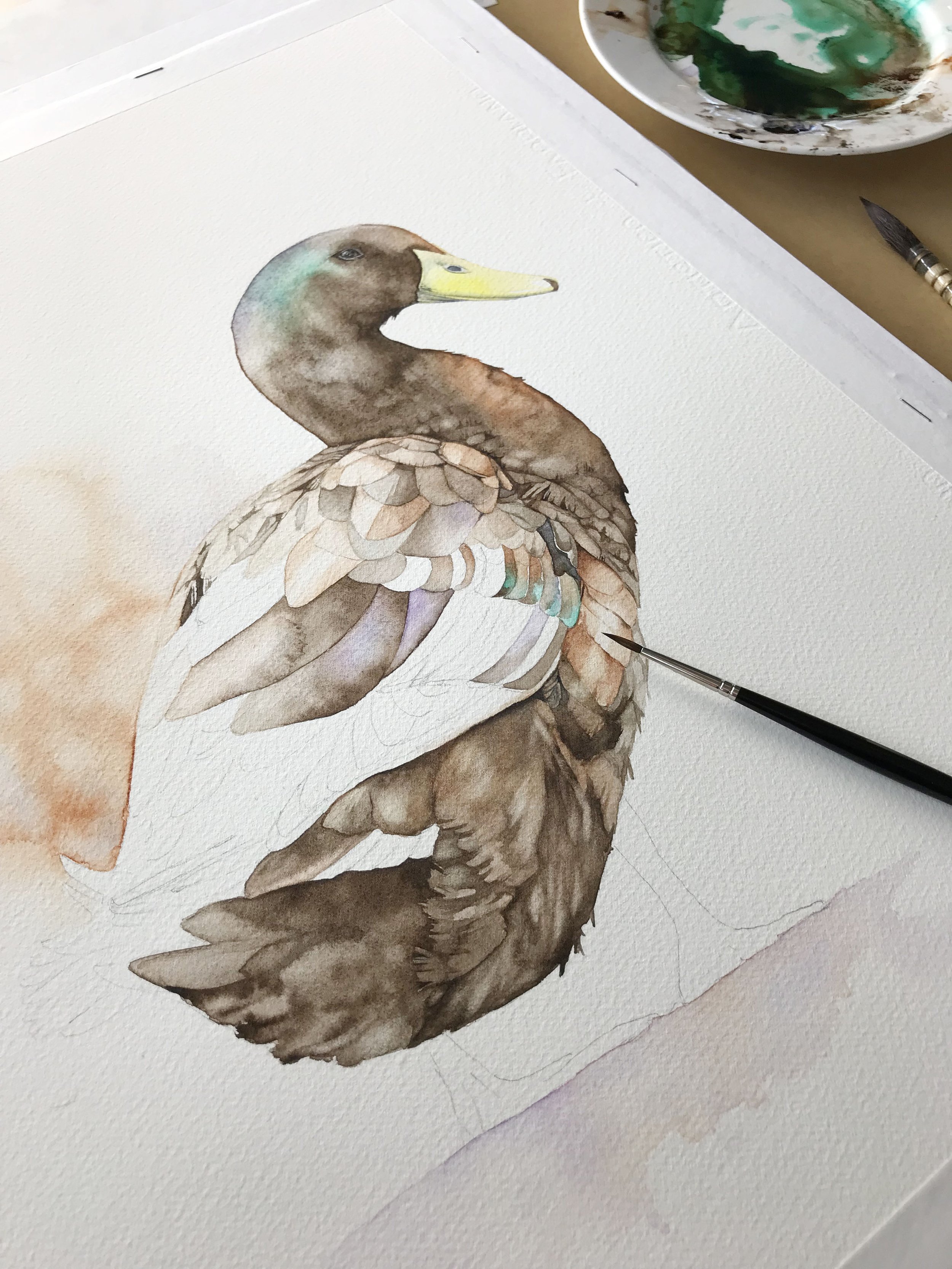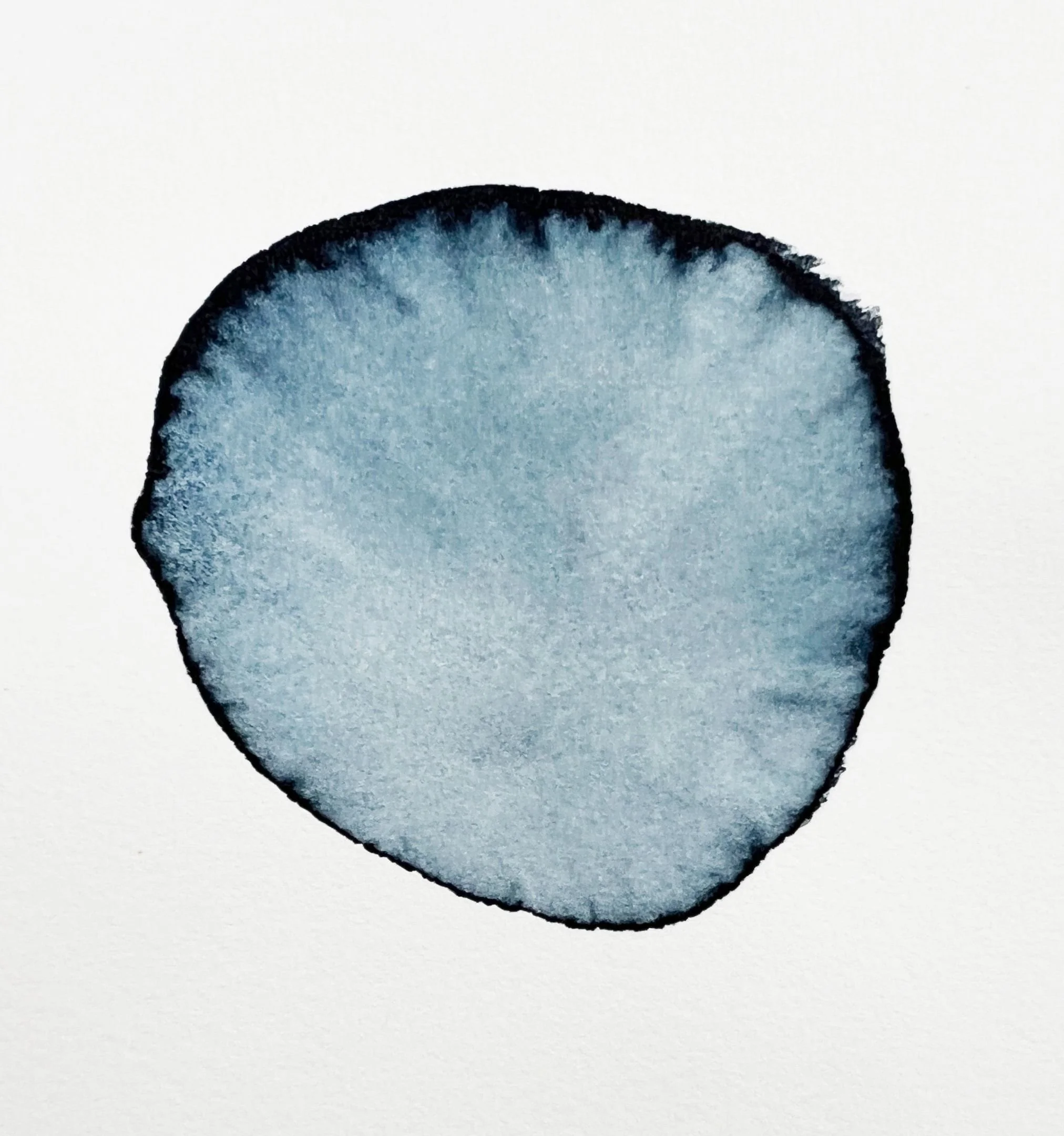The Versatility of Watercolour: A Journey Through Painting Styles
Watercolour, with its ethereal charm and fluidity, is a medium that dances between the lines of predictability and spontaneous surprise.
Today, let's embark on a journey exploring the versatility of watercolour, showcasing how it transcends beyond a singular style to express a myriad of artistic voices. From the meticulous details of realism to the boundless freedom of abstract art, watercolour is a testament to the endless possibilities that lie within a single brushstroke.
As we explore the versatility of watercolour, let's also pay homage to some of the masters who have pushed the boundaries of this medium, showcasing its capacity to capture a vast array of artistic expressions.
A watercolour painting of a duck - a realistic painting art style which is just one of the many painting styles.
Realism: The Art of Precision
Albert Dürer's 'Young Hare' 1502 an example pf Renaissance art - showcases Dürer's skill in observing and rendering the natural world with an almost scientific precision.
In realism, watercolour becomes a tool for meticulous representation, where controlled brushstrokes and fine details come to life. Whatever your paint style, it's all about careful colour mixing to capture the light, shadows, and textures that define our reality. The challenge here is to maintain the fluidity of watercolour while achieving a high level of detail that demands patience and a steady hand.
In the realm of realism, where controlled brushstrokes and fine details reign supreme we can learn from many famous artists. The work of Albrecht Dürer stands out. Dürer's "Young Hare" (1502) is a testament to the power of watercolour to capture life with startling accuracy. His meticulous approach to colour mixing and detail brings the subject to life, demonstrating the potential of watercolour in achieving realism.
Realism Reimagined
Artists like Steve Hanks have taken realism to new heights with their watercolour paintings. Hanks' works, known for their emotional depth and extraordinary realism, capture the human condition in a way that is both poignant and breathtaking. His mastery of light and shadow, combined with a profound understanding of watercolour, demonstrates the medium's capability to convey complex narratives through realism.
Steve Hanks 'Leaving in the Rain' - masterful use of light, colour, and water enhances the painting's realism and emotional resonance, making it a poignant representation of the human experience.
Impressionism: Capturing the Moment
Monet's 'Woman with Parasol’.
As we shift towards impressionism or loose work, watercolour reveals its ability to capture the essence of a moment. This painting style is characterised by loose brushwork and visible brushstrokes, where the emphasis is placed on light and colour over intricate detail. It's a dance with watercolour, allowing the medium to flow and blend, creating evocative scenes that stir the soul.
Monet's "Woman with a Parasol" (although not a watercolour painting) is a perfect example of the Impressionist painting style, showcasing the artist's mastery in capturing the fleeting effects of light and atmosphere. This piece of visual art, created by one of the most famous artists of the 19th century, depicts an elegant figure against a vibrant, dynamically brushed sky, capturing the quick movement and immediate feelings that are important to Impressionist art.
Though not typically categorised under the impressionist painting style, Winslow Homer's 'The Blue Boat'(1892), exemplifies how his loose brushwork technique and attention to light can evoke powerful atmospheric effects.
Winslow Homer's 'The Blue Boat' 1892
The New Impressionists
Photo from the book: 'Brushes with History- Masters of Watercolour' by Linda and David Van Nunen. Alvaro Castagnet infuses traditional watercolour techniques with his own style, creating a unique and vibrant presence in modern art. His bold colours and dynamic use of light bring urban and natural landscapes to life with remarkable spontaneity and fluidity.
Contemporary artists like Alvaro Castagnet carry the impressionist torch into the 21st century with their dynamic use of colour and light.
Castagnet's cityscapes and landscapes vibrate with life, his bright, loose brushwork capturing the fleeting moments of everyday scenes. His work encourages viewers to see the world through an impressionistic lens, where colours merge and dance in the viewer's eye.
Abstract Art: A Playground of Colour and Texture
Although this is an oil painting, Wassily Kandinsky's "Improvisation 26" stands as a testament to the daring spirit of early 20th-century abstract artists. With its bold colours swirling across the canvas, the painting invites viewers into a world where emotion and expression take precedence over literal representation.
Abstract watercolour is where the conventional rules bow out, and experimentation takes the lead. This style of painting is about exploring paint applications, textures, and colour theory. Abstract art invites artists to play, to discover the unexpected connections between colours, and to create compositions that resonate with emotion and energy.
When it comes to abstract painting in watercolour, Wassily Kandinsky leads the way. Kandinsky's use of vibrant colours and fluid forms invites viewers into a non-representational world, highlighting watercolour's ability to convey emotion through abstraction.
Abstract Dimensions
Bridget Riley's painting "In Attendance" showcases her signature style of optical art through the meticulous arrangement of geometric forms and bright colors. (abstract art)
Artists such as Bridget Riley have explored the abstract possibilities of Gouache and Watercolour, using the mediums to investigate visual perception through precise, geometric patterns. While Riley is predominantly known for her op-art in other mediums, her forays into watercolour exemplify how abstract compositions can manipulate space and colour, challenging the viewer's perceptions.
Expressionism: Bold and Unrestrained Artistic Movement
Expressionism in watercolour is marked by bold colour choices and dynamic, confident brushstrokes. It's an expressive dance, a way to convey internal emotions through the medium's vibrant hues and spirited application. Expressionism challenges artists to push boundaries, to use colour and form in ways that convey meaning beyond the literal.
Expressionism's bold colours and dynamic compositions are vividly represented in Emil Nolde's watercolours. Nolde's "Red Flowers" (1930) uses watercolour to express intense emotions through bold, saturated hues and sweeping brushstrokes, demonstrating the medium's capacity for expressive freedom.
Expressive Boldness
Contemporary expressionist artists like Sargent Claude Johnson use watercolour to explore identity, culture, and emotion with bold, vibrant colours and dynamic compositions. Johnson's work, rich in symbolism and narrative, showcases the medium's ability to convey powerful messages and evoke strong emotional responses.
Minimalism: The Essence of Simplicity
In minimalism, watercolour is stripped down to its core—restrained brushwork, a limited colour palette, and a strong emphasis on composition and balance. This art style is about finding beauty in simplicity, where each stroke and colour choice is deliberate and full of purpose. Minimalism teaches us that sometimes, less is indeed more.
Agnes Martin, known for her minimalistic painting style, although primarily associated with oils and acrylics, also explored the simplicity and subtlety of watercolour. Her works, such as "Untitled" (1960), focus on the essence of form and colour, embodying minimalism's restrained beauty through watercolour.
Minimalist Reflections
Ian Davenport, with his minimalist approach, showcases how paint can be used in highly controlled, yet seemingly simple compositions. Davenport's methodical dripping of paint creates works that are both rhythmic and serene.
Illustrative: Telling Stories Through Colour
Beatrix Potter's illustrative style of watercolour painting is celebrated for its delicate precision and vibrant detail. A classic example of her painting style can be seen in "The Tale of Peter Rabbit," where her skillful watercolours bring to life the whimsical world of her characters with enchanting clarity.
The illustrative approach to watercolour brings stories, concepts, or characters to life through clear, precise lines and colours. It's where art meets narrative, blending the fluidity of watercolour with the clarity of illustration. This style is perfect for those who wish to convey stories or messages within their art, marrying visual appeal with storytelling.
Beatrix Potter, beloved for her charming children's books, utilised watercolour to bring her characters to life. The illustrations in "The Tale of Peter Rabbit" (1902) showcase watercolour's ability to convey narrative and emotion through delicate, precise brush strokes and soft colours.
Illustrative Narratives
Julie Vivas is an Australian artist renowned for her distinctive and expressive illustrations in children's literature. Her work is characterised by its warmth, fluidity, and remarkable ability to capture the whimsical essence of childhood. She gained widespread recognition with her illustrations for "Possum Magic," written by Mem Fox, a book that has become a classic in Australian children's literature. Her unique artistic style, which often features soft watercolours and dynamic, almost ethereal, representations of characters, brings stories to life with a gentle yet vivid imagination.
Illustration by Julie Vivas in the book 'Possum Magic' by Mem Fox.
Mixed Media: The Art of Combination
John Singer Sargent's 'Carnation. Lily, Lily, Rose painting (oil).
Finally, the mixed media approach celebrates watercolour's ability to play well with others. By combining watercolour with pencil, gouache, charcoal, ink, or collage, artists can explore new textures, contrasts, and dimensions. Mixed media is about breaking the confines of a single medium to create artworks that are rich, layered, and deeply personal.
I enjoy using mixed media, especially pen & wash. You can purchase an individual tutorial on pen & wash here on my art school, or find it through the Patreon index.
In the world of mixed media, the innovative works of John Singer Sargent highlight the versatility of watercolour when combined with other materials. His piece "Carnation, Lily, Lily, Rose" (1885–86), though primarily an oil painting, shows how his approach to light and colour in oils informed his watercolour technique.
Fusion of Media
Contemporary mixed media artists like Sigrid Calon blend watercolour with digital techniques, embroidery, and other mediums to create innovative, layered works. Calon's exploration of pattern and colour through mixed media expands the possibilities of watercolour, merging traditional techniques with contemporary technology.
Another artist whose work I greatly admire is John Lovett. He's an Australian artist renowned for his mixed media works. He masterfully combines various painting styles to create dynamic and captivating pieces. His artwork is characterised by bold strokes and vivid colours, elements that add depth and movement, engaging the viewer's senses. Lovett blends techniques and materials, incorporating elements of watercolour, ink, and charcoal among others, to construct complex layers and textures. This approach allows him to capture the essence of his subjects, ranging from rustic landscapes to urban scenes, with a unique vibrancy and energy.
The Universal Medium: Embracing the Versatility of Watercolour
Watercolour's versatility isn't just confined to its ability to adapt to various artistic styles or the breadth of its palette. Its true magic lies in its accessibility, its capacity for spontaneity, and its unique ability to merge with the artist's intentions, making it a profoundly personal medium.
Accessibility and Universality
Watercolour is celebrated for its accessibility. With just a few basic supplies—a set of paints, brushes, and paper—anyone can begin their journey into the world of art. This ease of entry makes watercolour a universally beloved medium, embraced by hobbyists and professional artists alike. It demystifies the process of art-making, opening the doors to creative expression for people of all ages and skill levels.
The Magic of Spontaneity
The inherent unpredictability of watercolour is where its spontaneity shines. Unlike other mediums where control and precision can dominate, watercolour invites a dance with chance. This partnership with the unexpected encourages artists to embrace imperfections, learn from the happy accidents, and find beauty in the serendipitous merging of colours and forms. This aspect of watercolour teaches flexibility and resilience, traits valuable both on and off the canvas.
A Conduit for Personal Expression
Perhaps the most profound attribute of watercolour is its ability to become a conduit for personal expression. It responds uniquely to each artist's touch, from the amount of water used to the pressure of the brushstroke. This intimate relationship between the artist and the medium allows for deeply personal artworks that are as varied as the individuals creating them. Watercolour can convey the subtlest of emotions, the tranquility of landscapes, or the vibrancy of urban life with equal efficacy.
A Journey Without End
The journey of exploring watercolour is endless. As technology and materials evolve, so too will the techniques and applications of watercolour, promising a future where its versatility will only expand. From digital watercolour simulations to innovative water-based media, the evolution of watercolour is boundless.
In closing, watercolour is not just a medium; it's a journey, a teacher, and a friend to artists worldwide. Its versatility bridges past and present, tradition and innovation, simplicity and complexity.
Watercolour: A Canvas of Infinite Possibilities
Each of these styles showcases the remarkable adaptability of watercolour, a medium that can convey the finest details of reality or the deepest expressions of the abstract. Whether you're drawn to the precision of realism or the freedom of expressionism, watercolour offers a universe of possibilities waiting to be explored. So, why not pick up your brush and see where watercolour can take you? Remember, in the world of art, there are no mistakes, only discoveries.
If you are interested in learning to paint in watercolour, I have over 170 online, voiced over watercolour tutorials for all skill levels.
















